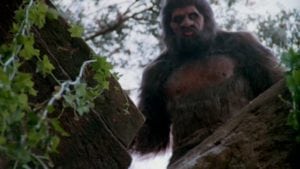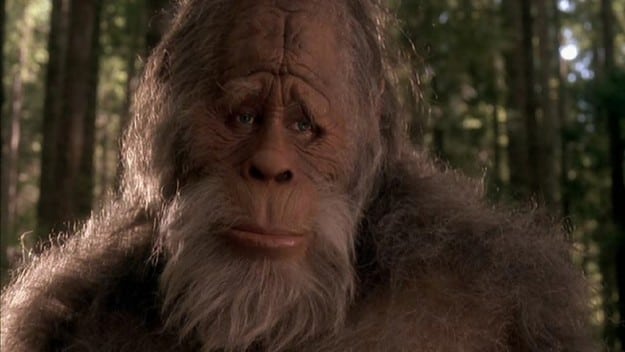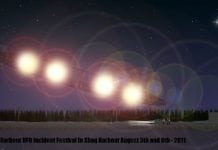Is Bigfoot Real? What made the oversized tracks found in Bluff Creek, California, and other parts of America? A giant ape or just a big jape?
In 1924, a group of miners working in the Cascade Mountain Range in the state of Washington were startled to see a huge simian creature staring at them from behind a tree.
Panic-stricken, one of the men fired at it and although the bullet appeared to hit the giant ape in the head, the beast ran off, apparently unharmed.
Soon afterwards another of the miners, Fred Beck, spotted it again on the edge of a canyon and again fired, this time hitting the creature in the back. The group watched as it fell over the ridge.
They scrambled at once down into the canyon below, but could find no trace of the creature’s body.
However, that evening as it grew dark, the men heard strange scratching noises outside their log cabin and saw shadowy gorilla-like faces at the window. The terrified miners barricaded the door but soon the creatures were hammering at the roof and walls.
Heavy rocks were thrown and the cabin rocked from side to side. The men began shooting through the walls in all directions but still the hammering continued, only ending as the sun rose the next morning. The miners packed up at once and left the cabin, vowing never to return.
It was only after Eric Shipton famously photographed a giant footprint on the Menlung Glacier of Mount Everest in 1951, putting his pickaxe alongside to show its size, that interest in giant apes began to gather pace.
During the 1953 expedition to Everest, when Edmund Hillary and Sherpa Tensing were the first to successfully climb the mountain, both men reported seeing oversized footprints.
Although Hillary later disputed that these were yeti tracks, there was so much interest in finding out more that the Daily Mail sponsored a ‘Snowman’ expedition in the Himalayas the following year. Keen to discover more about America’s very own yeti-style legend, John Green tracked down Fred Beck in the late 1960s and interviewed him for his book On the Track of the Sasquatch, and the Bigfoot mystery took even firmer root in America.
The word ‘Sasquatch’, applied to the large, hairy hominid in its North American manifestation, was first coined much earlier – in the 1920s – by J. W. Burns.
While working as a schoolteacher at the Chehalis Indian Reserve on the Harrison River, he had learned that Native American Indians used the words soos-q’tal and sokqueatl to describe the various ‘giant men’ of their legends.
To simplify matters, Burns decided to invent one name to cover all such creatures, and through one of his articles – ‘Introducing British Columbia’s Hairy Giants’, published in MacLean’s Magazine in 1929 – ‘Sasquatch’ passed into wider use.
As the public fascination for the giant apeman grew, the media began to report sightings on a regular basis. In 1958 road construction worker Ray Wallace was amazed when his colleague reported finding huge footprints in the dirt at Bluff Creak in northern California, the area they were working in.
The local press descended and soon the story was front-page news all over America. Casts were made of the prints, which experts declared genuine. The first newspaper to carry the story, the Humboldt Times of Eureka in California, used the name ‘Bigfoot’ in their headline, and the word has since become synonymous with America’s favourite mystery creature.
When more tracks were found, Sasquatch hunters flocked into the now famous Bluff Creek area to see what else they could discover.
It wasn’t until Ray Wallace’s death, in December 2002, that the mystery was revealed. Members of Ray’s family requested that his obituary should announce that, with his passing, Bigfoot had also died.
Ray Wallace immediately became one of the most controversial characters in Bigfoot history when it was revealed that he (along with a handful of his close friends and co-workers) had made the tracks.
Investigators soon found out that all of the tracks appeared in areas Ray had worked in. In the early days that had been in Washington State, where the first footprints had been found, while over twenty years later discoveries were being made further south, in California.
Bigfoot had not been on the move, Ray Wallace had. Family members produced dozens of different oversized foot moulds made out of wood or clay that Ray would have spent weeks crafting and honing.
His buddies, by then rather elderly pranksters, showed in television documentaries how they had created the vast footsteps: holding on to a rope tied to the back of a logger’s truck being driven very slowly had enabled them to take the giant steps that had so fooled expert analysis.
In much the same way as crop-circle makers simply enjoy confounding the experts, so did Ray and his pals.
However, despite The New York Times running the news as a headline story, many Bigfoot researchers have discounted the revelation (not altogether surprising – cynics might say – when their credibility was on the line) and even tried to discredit the Wallace family, threatening them with legal action.
One poor haunted soul who spent his adult life in search of Bigfoot evidence wondered why anybody would put so much time into ‘messing with people’s heads’. The answer, of course, is because it is fun. Fun, and surprisingly easy.
Nonetheless, a number of scientists and leading members of the Bigfoot Field Research Centre (BFRC) are, instead, stating that the footprint moulds produced by the pranksters are themselves the fake, not the tracks. In a bizarre piece of reverse logic, some are insisting the Wallace family must prove their claims.
John Green, described as one of America’s foremost Bigfoot researchers, loftily remarked of Wallace that if he had revealed the footprint mould during his lifetime he ‘would, of course, [have been] called upon to prove himself’.
I am unable to see how anybody can become a ‘foremost researcher’ when they have discovered exactly the same amount of genuine evidence of Bigfoot as I have – that is, absolutely nothing.
It was, after all, John Green who interviewed Albert Ostman in 1957 and fell for his tall (in more senses than one) story. Ostman said he had been looking for gold in British Columbia during the gold rush of 1927, when he had been kidnapped by an adult male Sasquatch. The beast gathered up the man in his sleeping bag and carried him several miles.
He was then dumped on the ground and realized, shortly afterwards, that he was being held by a family of four who would not let him leave their camp. After six days of captivity, he concluded he was being considered as future husband material for the young female, so he fired his rifle into the air, distracting the family for long enough to make his escape.
When Green asked why Albert had not told his story before, the ageing gold prospector replied that he thought nobody would have believed him. And few did, except John Green and his vast fan base of Bigfoot believers ready to leap to his defence on every issue. But Green did finally concede, in 2007, that he ‘would not believe the story if he were told it today’.
Take another established piece of ‘proof’ – the footage of a female Sasquatch filmed by Roger Patterson in Bluff Creek. The story goes that in October 1967 Patterson and his friend Bob Gimlin were riding through the creek when their horses reared up and they were both thrown to the ground.
Extract from Mysterious World
As they picked themselves up, they noticed a ‘huge, hairy creature walking like a man’ about thirty yards ahead of them.
Patterson grabbed his cine-camera and began filming the beast as she loped away, pausing only once – and looking directly into the camera lens as she did so – before disappearing from view.
The film has become world famous and has been studied by zoologists, crypto-zoologists, palaeontologists, biologists, anthropologists, archaeologists, Uncle Tom Cobbley and all. And you will be unsurprised to hear that opinion is divided about whether it is genuine footage (Bigfootage?) or not.
Leading scientists did, however, conclude at the time that there was ‘nothing in the film that leads them, on scientific grounds, to suspect a hoax’. Having now made my own detailed study of the film, using ultra-slow, frame-by-frame-pausing technology obligingly provided by Sony (namely, the DVD player in my front room), I can now add to the debate.
To my albeit untrained eye, the creature looks suspiciously like a man in a monkey suit on his way to a fancy-dress party.

Seasoned Bigfoot researchers nevertheless regard the film as a significant piece of evidence, saying that to suggest that it was a hoax would be ‘demonstrably false’ – that old double-negative rhetoric again.
But even non-researchers, including the physical anthropologist Grover Kranz, confirm the film does depict a ‘genuine unknown creature’. Another prominent primate expert, John Napier, is still not entirely convinced but once revealed:
‘I could not see the zipper then and I still can’t. Perhaps it was a man dressed up in a monkey costume; if so it was a brilliantly executed hoax and the unknown perpetrator will take his place with the great hoaxers of the world.’ So does this mean if he can’t see the zip, it can’t be a monkey suit? Or had the hoaxer compounded his/her cleverness by inventing an early form of Velcro?
In 2004, Greg Long revealed in his book The Making of Bigfoot that the grainy clip was in fact an elaborate hoax. Long claims he had managed to trace the monkey suit to costume maker Philip Morris, a gorilla suit specialist from North Carolina.
In the book, Morris states he sold the suit to Roger Patterson for $435, and when he saw the Bigfoot photos on the television and in the newspapers a few weeks later, he recognized the suit as the one he had made.
Morris claims never to have revealed this information before because to break ‘client confidentiality’ in such a public manner would have lost him customers. It might have saved millions of research dollars, though.
Greg Long revealed the man in the suit as Bob Heironimus – a friend of Patterson’s – who subsequently told the Washington Post: ‘It’s time people knew it was a hoax. It is time to let this thing go … I have been burdened with this for thirty-six years, seeing the film-clip on television numerous times. Somebody’s making lots of money out of this, except for me. But that is not the issue, the issue is that it is finally time to let people know the truth.’
John Green, of course, immediately went on the offensive, calling him a liar and declaring Greg Long had made ‘a fool of himself’.
And while Heironimus was a known associate of Patterson and has passed two lie detector tests and Greg Long has found several independent, but supporting, witnesses, John Green still has yet to provide a single piece of evidence for his case that the film is of a genuine, if as yet unidentified, hairy giant.
Step forward, then, Roger Patterson himself. Unfortunately, he can no longer be called upon as he died in 1972. However, the other witness to the Bigfoot sighting, Bob Gimlin, is still alive. Bob no longer speaks personally about the film as he is ‘fed up with the whole Bigfoot thing’, but his solicitor, Tom Malone, issued a statement to the Washington Post in response to their story about Heironimus’s revelation:
‘I am authorized to tell you that nobody wore a gorilla suit or monkey suit and that Mr Gimlin’s position is that it’s absolutely false and untrue.’ Which seems clear enough, but it is quite possible Gimlin didn’t know about Patterson’s hoax and was simply used to increase its credibility.
Even if he was in on the act, Gimlin has always maintained the film to be genuine and so any revelation now, forty years after the event, would be somewhat embarrassing for him.
In 1969, another set of tracks was reported – in Bossburg, Washington – that, on closer inspection, revealed the giant beast’s right paw was in fact club-footed. Experts argued that this indicated that the tracks were very likely to be the first genuine piece of evidence to support the existence of the Sasquatch. Professor John Napier, whose book Bigfoot was published in 1973, wrote:
‘It is difficult to conceive of a hoaxer so subtle, so knowledgeable – and so sick – who would deliberately fake a footprint of this nature. I suppose it is possible but so unlikely I am prepared to discount the idea it is a hoax.’ Straight from the school of ‘If I couldn’t think of it then nor could anybody else’, and with such imaginative minds on the trail of Bigfoot, it is hardly surprising he has managed to elude us for so long.
Despite sightings of Bigfoot reported in every American state except Hawaii and Rhode Island, the creature’s natural habitat is said to be the remote woodlands and forests in the Pacific Northwest of America and Canada. The Rocky Mountains have provided many sightings, as have the Great Lakes.
But if this is the case, how could he have got to Florida, California and other southern states? The Sasquatch would have had to leave the cover of his remote woodland hideaway, and it is difficult to imagine how such a creature could travel so far without leaving behind at least some credible evidence. You would certainly spot him in the Greyhound bus queue.
But, unfortunately for the wonderfully named Texas Bigfoot Research Center (TBRC), it turns out that most of the evidence found, such as blood or hair samples, footprint casts or photographs, usually turn out to be fake and never, as yet, from an unknown creature.
Investigators at TBRC say they receive reports of over one hundred sightings each year in Texas alone, while on the homepage of their website Janet Bord states: ‘If the skeptics are right and there is no such creature as Bigfoot, then it is a fact that thousands of Americans and Canadians are either prone to hallucinations, or are compulsive liars or unable to recognize bears, deer and vagrants.’ Quite how tramps became involved is anybody’s guess.
Also on the homepage of the TBRC website is something that bears further examination. One Rick Noll is quoted, stating his reasons why no firm evidence for the existence of a big, hairy, part-man, part-simian-type monster has been found:
- No one is spending enough time in the woods,
- Not many people know what to do in searching, overlooking things, or vice-versa, seeing things that aren’t significant [sic] to the task,
- There are not many of these animals around,
- They, like most animals in the forest, know how to camouflage themselves quickly and easily,
- Most encounters with humans are probably mistakes on the part of the Bigfoot, yet researchers are trying to fill in the picture with them as to being something significant.
So there you have it. Those are the reasons the TBRC claim there is, to date, still no credible evidence of the existence of Bigfoot. So how is it then that, despite the use of the whole spectrum of technology – from heat-seeking cameras with night vision to thermal imaging – nobody has confirmed the existence of Bigfoot?
Bigfoot enthusiasts apart, the group of people keenest to obtain as much information as possible of the apeman’s existence would be the US government. And as they have surveillance equipment that can detect a small nuclear warhead buried in the desert somewhere near Baghdad, it is fair to assume they would have picked up one of the thousands of Sasquatch that have to exist if all the Americans and Canadians who claim sightings are not lying.
Such a large number of sightings does suggest that Bigfoot, or a relative of his, could well be out there; indeed I, like Janet Bord, refuse to believe that so many people can be lying. But hundreds of small, circumstantial and improvable reports do not add up to a single, solid fact. It is like pouring thirty separate measures of Jack Daniels into a large glass.
Added together they do not make the drink any stronger in flavour; it still tastes exactly the same. But if you drink it all – as I have discovered through experimentation for this very investigation on your behalf – you will fall over. Scientifically speaking, weak evidence should not become any stronger just because there is lots of it, although it can affect your judgement in the end.
But the Texas Bigfoot Research Center is not the only organization dedicated to finding firm evidence: there are many others throughout America. On 27 December 2003, for example, the Pennsylvania Bigfoot Society (PBS) hosted their fifth annual East Coast Bigfoot Conference (ECBC), and the keynote speaker, Stan Gordon, veteran researcher and the founder/director of the Pennsylvania Association for the Study of the Unexplained (PASU), concluded his opening speech linking Bigfoot sightings with known UFO activity in the same areas – although he stopped short of announcing: ‘Bigfoot is a spaceman.’
Which I would have done, just for the headline. leave in ‘There is no doubt the evidence suggests there is something out there,’ he assured the audience, as they sat there hanging on his every word, then continued: ‘We just don’t know what it is.’

Another speaker at the conference, Paul Johnson, a chemistry professor at Duquense University in Pittsburgh, thought he knew: ‘Bigfoot is a quantum animal that moves freely between the real world as we know it and a quantum world outside the reach of conventional laws.’ He went on to explain how that, in quantum physics, electrons do not follow the normal rules of physics.
Although he admitted his ideas were unconventional, he also noted (contradicting himself in the process) that nothing as large as Bigfoot could behave like an electron in reality, which was a relief because everybody knows that a living being is unable to dematerialize and then reappear in perfect working order in another place. Unless, of course, you are travelling on the starship Enterprise,and then you can.
Another speaker at the ECBC, Janice Coy from Monroe County, Tennessee, claimed her family had developed a relationship with a family of Bigfoot (or should that be ‘Bigfeet’?) since 1947. Her grandfather, having stumbled across an injured Bigfoot, had bandaged its broken leg and allowed it to recover in a barn at the family farm.
She claims to have even held a baby Bigfoot in her arms and explained that for years she had tried to obtain photographic evidence, without success.
She picked up on Paul Johnson’s quantum theory and suggested that was the reason none of her photographs ever returned to her with images any clearer than a ‘shapeless fuzz’. And no one likes to see a shapeless fuzz now, do they.
On one occasion the Sasquatch family, realizing the camera was present on a nearby tripod, used long sticks to retrieve food from a place out of range of the lens. On another occasion, the roll of film Janice submitted to a commercial processing lab returned to her after the film had been mysteriously overexposed, and every image lost for ever.
She also claimed she was trying to obtain DNA evidence to provide comprehensive proof of the family’s existence; no one asked her why she didn’t just pinch a couple of hairs from the baby she had held in her arms. That would have been enough to prove her bizarre claims. But that’s enough about the ECBC, so let’s move on.
Where DNA testing has been carried out on purported evidence, none has been proven to come from an unknown beast. Usually Bigfoot hairs are found to have come from bison or other common animals.
The absence of fossil evidence is another powerful argument that Bigfoot does not exist, although believers counter this by suggesting that the absence of fossil evidence is not yet evidence of fossil absence, and so it goes on and on and on.
But the fact remains that not a single hair, bone, tooth, nail or claw has ever been found that belongs to a giant hairy man-like being that cannot be explained, and yet there is plenty of evidence found in similar areas that bears, moose, deer and even dinosaurs and hairy mammoths have left their traces behind them. So why not Sasquatch, if there is one?
The late professor Grover Krantz, a reputable anthropologist, was one of few scientists to state publicly that he believed in Bigfoot. He personally interviewed hundreds of witnesses, studied film footage and photographic evidence and inspected many plaster casts of footprints and other imprints.
He estimated that between 200 and 2,000 Bigfoot lived in the Pacific Northwest of America and dedicated his life to proving it, but he never turned up any credible evidence that could be regarded as anything approaching proof.
However, the professor was unabashed, once suggesting that most animals hide before they die and their bodies are quickly devoured by scavengers, noting that he had ‘yet to meet anyone who has found the remains of a bear that was not killed by human activity’. Which is a fair point, but then he hasn’t met everybody yet, has he?
It was Grover Krantz who announced to the world that the club-footed prints had offered the ‘first convincing evidence that the animals were real’. He also said of other tracks he had studied that a ‘push-off mound’ was ‘impressive evidence’ to him.
This was a small mound of soil, present in some Bigfoot tracks, that Krantz had decided was created by the ‘horizontal push of the front foot just before it leaves the ground’. He stated with authority that no artificial rubber or wooden mould would leave such an impression.
More recently, in 2005, a story was told of a young Bigfoot that had been accidentally caught in a bear trap. A boy and his father had taken the beast back home and put him in a cage, but when the Bigfoot became distressed, the boy’s father let it go. In a world where everybody now has video cameras, even on their mobile telephones, it is a hard to believe that their first instinct wouldn’t be to take a close-up picture of the creature. Quite frankly, although this story is reported as genuine, if it turns out to be true, then I will shave my head and become a French monk.
So, in summary, what is still needed is a carcass. That would be ideal, although any Sasquatch fossil or bone would do – just something more convincing that the plaster mould of an oversized footprint made by a carved wooden or plastic shape strapped to the foot of a prankster being pulled along by a slow-moving truck to help create the effect of giant footsteps that ‘man could not possibly have made’. Even the apparently genuine footprints look suspicious to me.
Look again at the assessment of the small mound of earth focused upon by the expert Dr Grover Krantz – caused ‘by a horizontal push of the front foot just before it leaves the ground’.
Now go and have a walk across your living room like I just did, and notice how your front foot never leaves the ground, until the other one passes it of course, but by then it is your back foot. So what is he talking about?
Extract from Mysterious World
As every single apparently credible piece of material evidence of Bigfoot has turned out to be a hoax, then there is nothing else for it – we do need a carcass. Indeed Krantz himself believed this would be the only way to finally remove any doubt in people’s minds as to the existence of Bigfoot, and he called for hunters to bring one in.
But that also worries me, because what if the one that is shot turns out to be the only one? Hold your fire after all, fellas …
Either way, the search, for some, will continue and groups of people known by their initials, including Central Ohio Bigfoot Research (COBR) and the Gulf Coast Bigfoot Research Organization (GCBRO), will continue to flourish and attract new members and devise new acronyms.
I might even start my own group and call it the Time Wasters And Tricksters Society, of which I am told by some that I am perfectly qualified to be the president.
Because if enough people continue to insist Bigfoot, or Sasquatch, is alive and well somewhere in the wilderness, there will always be hoaxers leaving clues for them to find.
In reality, it will remain as impossible to prove Bigfoot does not exist as it is to prove you do not have a invisible, silent, pink lion standing in your garden, looking at you right now and thinking, ‘Lunch.’ You can’t prove there isn’t one, you know.
After all, any absence of evidence for invisible, silent, pink lions is not yet evidence of their absence. – Albert Jack
Albert Jack AUDIOBOOKS available for download here
Albert Jack’s Mysterious World







































